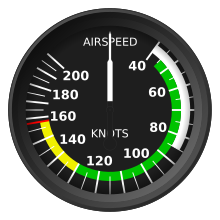Knot (unit)
| knot | |
|---|---|
 An airspeed indicator, which shows speed in knots | |
| General information | |
| Unit system |
|
| Unit of | speed |
| Symbol | kn, kt |
| Conversions | |
| 1 kn in ... | ... is equal to ... |
| km/h | 1.852 |
| mph | 1.15078 |
| m/s | 0.514444 |
| ft/s | 1.68781 |
The knot (
Definitions
- 1 international knot =
- 1 nautical mile per hour (by definition),
- 1852.000 metres per hour (exactly),[5]
- 0.51444 metres per second (approximately),
- 1.15078 miles per hour (approximately),
- 20.25372 inches per second (approximately)
- 1.68781 feet per second (approximately).
The length of the internationally agreed nautical mile is 1852 m. The US adopted the international definition in 1954, having previously used the US nautical mile (1853.248 m).
| m/s | km/h | mph (mi/h) | knot | fps (ft/s) | |
|---|---|---|---|---|---|
| 1 m/s = | 1 | 3.600000 | 2.236936* | 1.943844* | 3.280840* |
| 1 km/h = | 0.277778* | 1 | 0.621371* | 0.539957* | 0.911344* |
| 1 mph (mi/h) = | 0.44704 | 1.609344 | 1 | 0.868976* | 1.466667* |
| 1 knot = | 0.514444* | 1.852 | 1.150779* | 1 | 1.687810* |
| 1 fps (ft/s) = | 0.3048 | 1.09728 | 0.681818* | 0.592484* | 1 |
(* = approximate values)
Usage
The speeds of vessels relative to the
Origin
Until the mid-19th century, vessel speed at sea was measured using a
Derivation of knots spacing:
, so in seconds that is metres per knot.
Modern use

Although the unit knot does not fit within the SI system, its retention for nautical and aviation use is important because the length of a nautical mile, upon which the knot is based, is closely related to the longitude/latitude geographic coordinate system. As a result, nautical miles and knots are convenient units to use when navigating an aircraft or ship.
On a standard nautical chart using
Speed is sometimes incorrectly expressed as "knots per hour",[10] which would mean "nautical miles per hour per hour" and thus would refer to acceleration.
Aeronautical terms
Prior to 1969, airworthiness standards for civil aircraft in the United States Federal Aviation Regulations specified that distances were to be in statute miles, and speeds in miles per hour. In 1969, these standards were progressively amended to specify that distances were to be in nautical miles, and speeds in knots.[11]
The following abbreviations are used to distinguish between various measurements of airspeed:[12]
- TAS is "knots true airspeed", the airspeed of an aircraft relative to undisturbed air
- KIAS is "knots pitot-static airspeed indicator
- CAS is "knots calibrated airspeed", the indicated airspeed corrected for position error and instrument error
- EAS is "knots equivalent airspeed", the calibrated airspeed corrected for adiabatic compressible flow for the particular altitude
The indicated airspeed is close to the true airspeed only at sea level in standard conditions and at low speeds. At 11000 m (36000 ft), an indicated airspeed of 300 kn may correspond to a true airspeed of 500 kn in standard conditions.
See also
- Beaufort scale
- Hull speed, which deals with theoretical estimates of practical maximum speed of displacement hulls
- Knot count
- Knotted cord
- Metre per second
- Orders of magnitude (speed)
- Rope (unit)
References
- ISBN 9780850451634.
- ^ Bartlett, Tim (July 2008) [2003]. RYA Navigation Handbook. Southampton: Royal Yachting Association.
- ^ "ISO 80000-3:2006". International Organization for Standardization. Retrieved 20 July 2013.
- ^ International Standards and Recommended Practices, Annex 5 to the Convention on International Civil Aviation, "Units of measurement to be Used in Air and Ground Operations", ICAO, 4th Edition, July 1979.
- ^ a b "Non-SI units accepted for use with the SI, and units based on fundamental constants". SI brochure (8th ed.). International Bureau of Weights and Measures.
The knot is defined as one nautical mile per hour. There is no internationally agreed symbol, but the symbol kn is commonly used.
- ^ Louis E. Barbow and Lewie V. Judson (1976). "Appendix 4 The international nautical mile" (PDF). Weights and Measures Standards of the United States, A brief history. NIST Physics Laboratory. Archived from the original (PDF) on 26 September 2007. Retrieved 2 August 2007.
- ^ Jacob Abbott (1858). Rollo on the Atlantic. DeWolfe, Fiske, & Co., Publishers. Retrieved 30 November 2011.
- ISBN 0-19-282084-2.
- ^ E.g. BA Chart 73, Puerto de Huelva and Approaches, 2002
- The Kipling Society. Retrieved 1 December 2012.
Since the 1890s or thereabouts, it has been drummed into the young seaman that a knot is a unit of speed, namely, one nautical mile per hour; and that consequently only the uneducated speak of "knots per hour" or "knots an hour". It was therefore inevitable that Kipling's frequent use of this expression should grieve a number of seafaring readers, as the pages of the Kipling Journal testify.
- ^ For example, Part 23 of the Federal Aviation Regulations, amendment 23–7, 14 September 1969
- ^ "Abbreviations and symbols". edocket.access.gpo.gov.



